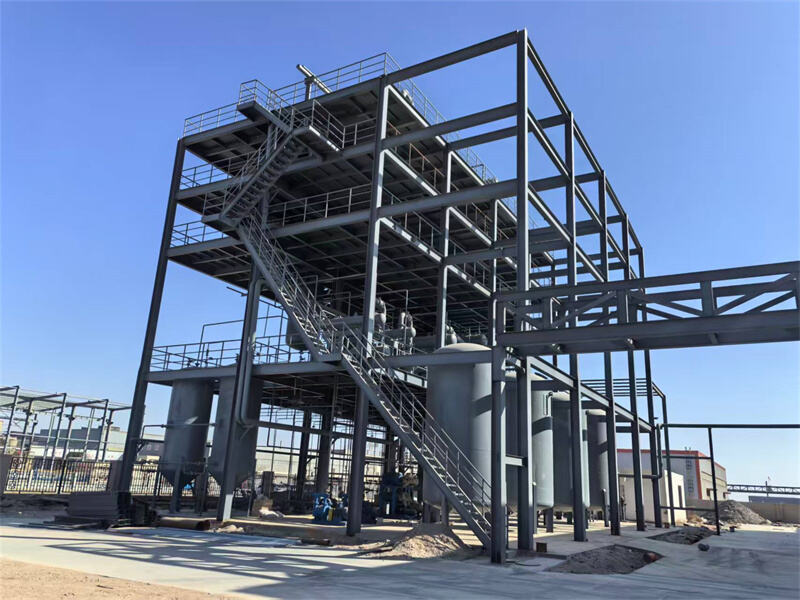Technical Proposal for Advanced Distillation Unit for Waste Plastic Pyrolysis Oil 1.0 Introduction & Objective This document outlines the technical for an advanced distillation system designed to upgrade crude oil derived from the pyrolysis of wa...

Technical Proposal for Advanced Distillation Unit for Waste Plastic Pyrolysis Oil
This document outlines the technical for an advanced distillation system designed to upgrade crude oil derived from the pyrolysis of waste plastics. The primary objective of this unit is to transform low-value, complex pyrolysis oil into high-quality, standardized distillate fractions (e.g., light naphtha, heavy naphtha, light gasoil) suitable for use as fuel blending components or chemical feedstocks. This proposal highlights the innovative features and significant technical advantages of our system over conventional distillation methods.
The proposed distillation process is a continuous, multi-stage fractional distillation system specifically engineered to handle the challenging composition of plastic pyrolysis oil, which contains contaminants, waxes, and a wide range of hydrocarbons.
The key stages include:
1. Pre-treatment & Filtration: Crude pyrolysis oil is first pre-heated and passed through a series of depth and cartridge filters to remove solid particulates and carbon black.
2. Preheating & Charge Heater: The filtered oil is efficiently preheated through heat integration with product streams before entering a specially designed charge furnace where it is heated to precise temperatures.
3. Atmospheric Fractionating Column: The vaporized oil enters a tall, structured-packing column. Different fractions are separated based on their boiling points:
Light Naphtha (IBP ~80°C): Collected overhead.
Heavy Naphtha (~80-180°C): Collected as a side stream.
Light Gasoil (~180-350°C): Collected as a side stream.
4. Condensation & Product Cooling: Vapors are condensed using shell and tube heat exchangers.
5. Vacuum Distillation (Optional): For systems targeting heavier fuel oil cuts or base oils, a vacuum distillation unit is integrated to lower the boiling points of heavy fractions, preventing thermal cracking.
Our distillation system incorporates several state-of-the-art technologies that provide unmatched performance, efficiency, and reliability.
Advantage: Significantly reduced operating costs and carbon footprint.
Technology: Integrated Heat Recovery System. Hot product streams (e.g., distilled gasoil) are used to pre-heat the incoming crude feed oil via plate heat exchangers. This design reduces the energy demand on the charge heater by up to 40% compared to non-integrated systems.
Advantage: Higher product purity and yield, with precise cut-point control.
Technology: Use of high-efficiency structured packing and distributor trays instead of traditional bubble trays. This provides:
Extremely low pressure drop, enhancing separation efficiency.
More theoretical plates for sharper separation between fractions.
Reduced fouling and clogging potential.
Advantage: Consistent product quality, operational stability, and reduced manual intervention.
Technology: A fully integrated Distributed Control System (DCS) with:
Continuous monitoring of temperatures, pressures, and flow rates.
Automated control of reflux ratios and draw-off rates to maintain product specifications despite feed variability.
Remote monitoring and troubleshooting capabilities.
Advantage: Extended run-times, reduced maintenance downtime, and higher annual capacity.
Technology: Proprietary design of the charge heater furnace tubes and column internals minimizes hot spots where coking occurs. An optional online spalling system can be incorporated to clean tubes periodically without shutting down the unit.
Advantage: Long service life and resistance to corrosion from acidic contaminants (e.g., chlorides) present in plastic pyrolysis oil.
Technology: Critical components, including the column internals, condenser tubes, and preheat exchangers, are constructed from SS 316L stainless steel and other specialized alloys to withstand corrosive environments.
Advantage: Ability to process a wide range of pyrolysis oil qualities and adjust product output based on market demand.
Technology: The modular design of the side-stream draw-offs and the tunable APC allow operators to easily change the boiling point ranges of the naphtha and gasoil cuts to target different specifications (e.g., diesel vs. marine fuel blending components).
The unit is designed to produce fuels that meet the following typical specifications:
Fraction | Boiling Range Typical Use | Key Quality Note
Light Naphtha IBP - 80°C Petrochemical Feedstock High paraffinic content
Heavy Naphtha 80°C - 180°C Gasoline Blending Component Low sulfur after optional hydrotreating
Light Gasoil 180°C - 350°C Diesel/Marine Fuel Blend High cetane index, low sediment
Closed-Loop Operation: Zero process water discharge. All vents are routed to a closed flare system.
Leak Detection & Prevention: Comprehensive system for early detection of hydrocarbons.
Safety Instrumented System (SIS): An independent, automated system designed to safely shut down the plant in case of any operational excursions.
This proposed distillation unit represents a significant technological leap in the valorization of waste plastic pyrolysis oil. By focusing on **energy integration, advanced separation, intelligent automation, and robust engineering**, the system delivers unparalleled advantages:
Higher Profit Margins: Through reduced utility consumption and premium product yields.
Exceptional Product Quality: Enabling entry into higher-value fuel markets.
Maximum Reliability & Uptime: Minimizing operational disruptions and maintenance costs.
Future-Proof Design: Offering the flexibility to adapt to evolving feedstocks and product requirements.
We are confident that this technology provides the optimal solution for building a sustainable and profitable business in the advanced recycling of waste plastics.
Pyrolysis Oil: Crude oil produced from heating waste plastics in the absence of oxygen.
Fractional Distillation: A separation process based on the different boiling points of components in a mixture.
Structured Packing: Material inside a column designed to maximize vapor-liquid contact for efficient separation.
Reflux Ratio: The ratio of liquid returned to the column versus product drawn off, a key parameter for controlling separation purity.
Cetane Index: A measure of the combustion quality of diesel fuel.